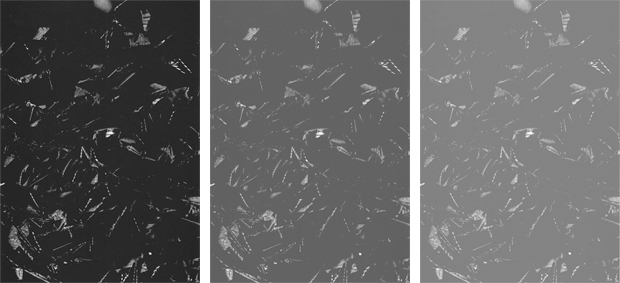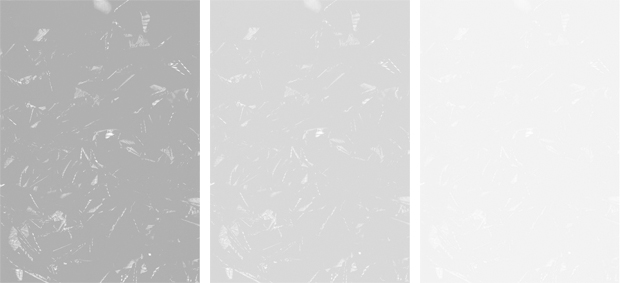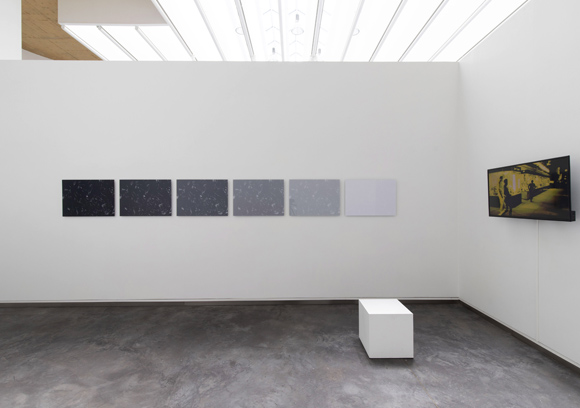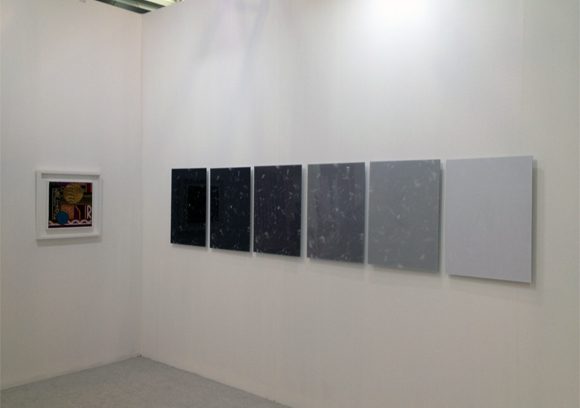| |
|
|
21.
| Black on black |
| |


Serie started in 2009, inkjet print, 70 x 50. Available in 135 x 100 cm.
Courtesy of the artist and ADN Galeria, Barcelona.
Ed. of 5 + 2 A.P.

Serie started in 2009, inkjet print, 70 x 50. Available in 135 x 100 cm.
Courtesy of the artist and ADN Galeria, Barcelona.
Ed. of 5 + 2 A.P.
'' Black on Black, presents a multiplicity of images in which there is nothing, or almost nothing, to see,
thus exposing the paradox of our modern society in which obsession with image leads to a progressive clouding of our vision, and ultimately to blindness. ''
Studio Fatmi, April 2017

Black on black
Exhibition View from The Day of the Awakening, CDAN, 2018, Huesca.
Courtesy of the artist.

Black on black
xhibition View from ARCO, 2013, Madrid.
Courtesy of the artist.
|
|
|
|
|
|
Noir sur Noir livre une série de photographies au format rectangulaire, réalisées à l'aide de photocopieurs professionnels et de bandes magnétiques de cassettes VHS, instruments datés de communication, de copie et de transmission des images. Les compositions obtenues sont presque entièrement noires, traversées par de rares points ou traits blancs correspondant aux passages aléatoires de la lumière des photocopieurs à travers les trous pratiqués sur les côtés des bandes magnétiques. Le dispositif d'impression est lui-même issu de l'installation Ghosting, structure murale composée de cassettes VHS dont les bandes magnétiques se déroulent au sol et sur les vitres de photocopieurs.
Mounir Fatmi interroge avec Noir sur Noir notre rapport aux images et à leur pouvoir, à la manière d’installations telles que Ghosting ou Le Mur, dont les dispositifs s'inspirent de courants philosophiques et de pratiques artistiques qui placent le rapport aux images au centre de leur réflexion. Ces types d’installation renvoient à la fois aux notions de médiatisation développées par Debord dans la Société du Spectacle, et aux techniques de répétition employées par le pop art et le minimalisme. Noir sur Noir pose plus précisément la question de la production et de la reproduction en masse des images et de ses effets sur les consciences. L’œuvre questionne enfin les moyens de l'art contemporain pour traiter des rapports entre image et société, et tente également de définir le rapport de l’artiste aux images et à leur pouvoir.
La série photographique Noir sur noir multiplie ainsi les compositions où il n'y a presque plus rien à voir et expose le paradoxe d'une organisation sociale où l'obsession de l'image conduit à un obscurcissement de la vision et à une progressive cécité. Cette société de l'image représente un défi pour l'artiste dont le médium est également l'image : comment traiter des images sans être automatiquement soumis à leur pouvoir d'aveuglement ? Mounir Fatmi trouve une solution à ce problème en poussant à leur paroxysme à la fois la logique de répétition du système de reproduction afin d'en révéler les effets pervers, et celle du processus artistique qui s'y inscrit, jusqu'à provoquer son détachement et sa relative autonomisation.
Studio Fatmi, avril 2017.
|
|
Black on Black is a series of rectangular photographs created using professional photocopiers and VHS cassette tape — out of date instruments used to communicate, copy and transmit images. The resulting compositions are almost exclusively black; rare specks and traces of white appear only where the light from the copier has managed to sneak through the holes of the VHS tape. These prints are the output of “Ghosting,” an installation that features a wall of VHS cassettes, their tape unspooled and draped over a copier in the center of the exhibition space.
With Black on Black, Mounir Fatmi questions our relationship to The Image, by unveiling the power that it wields. As in his installations “Ghosting” and “The Wall,” Fatmi is working within a tradition that places the question of the image at the center of his philosophic and artistic reflection. These projects reference ideas about the mediatization of society developed by Guy Debord in “The Society of the Spectacle,” and borrow artistic techniques from Pop Art and Minimalism. Specifically, the Black on Black series interrogates the mass production and reproduction of images, and the ensuing effect such images have on our conscious. In attempting to define a relationship between artist and image — while remaining ever-conscious of the image’s power — the work questions the role contemporary art plays in understanding image in our contemporary society.
Black on Black, presents a multiplicity of images in which there is nothing, or almost nothing, to see, thus exposing the paradox of our modern society in which obsession with image leads to a progressive clouding of our vision, and ultimately to blindness. The society of the image presents a fundamental problem for an artist whose medium is also the image: how does one work with images without being subjected to their blinding power? Mounir Fatmi’s solution to this problem is push these ideas to their logical conclusion, both in terms of production, where logic ordains that the reproductions be repeated ad infinitum in order to demonstrate the perversity of the enterprise, and in terms of the artistic process at the heart of the production which he automizes. In so doing he arrives at an automation of, and subsequent detachment from, the image.
Studio Fatmi, April 2017. |
|
|
|